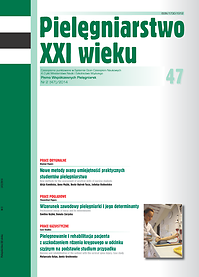Pielęgnowanie i rehabilitacja pacjenta z uszkodzeniem rdzenia kręgowego w odcinku szyjnym na podstawie studium przypadku
DOI:
https://doi.org/10.12923/Słowa kluczowe:
uszkodzenie rdzenia kręgowego, studium przypadkuAbstrakt
PIELĘGNOWANIE I REHABILITACJA PACJENTA Z USZKODZENIEM RDZENIA KRĘGOWEGO W ODCINKU SZYJNYM NA PODSTAWIE STUDIUM PRZYPADKU
Wprowadzenie. Szybkie tempo życia, brawura oraz brak rozwagi prowadzą często do tragicznych w skutkach wypadków rzutujących w konsekwencji na dalszą jakość życia pacjenta i jego rodziny. Ranga problemu niewspółmiernie wzrasta i jest bardziej złożona w związku z wysokością urazu, im wyższy poziom uszkodzenia rdzenia kręgowego, tym większy jest wpływ urazu na dalszą sprawność fizyczną i psychiczną chorego. Uszkodzenie rdzenia w odcinku szyjnym prowadzi do trwałych i nieodwracalnych zmian w funkcjonowaniu całego organizmu. Ogromna rozległość zaburzeń wymusza wielokompleksowy charakter działań podejmowanych już w pierwszych momentach po dokonanym urazie. Głównym celem powinno być dążenie do jak najwcześniejszego odbarczenia ucisku działającego na rdzeń kręgowy. Podejmowane działania operacyjne lub zachowawcze to jedynie początek długotrwałego procesu zmierzającego do przywrócenia utraconych funkcji. Osiągnąć to tylko można poprzez systematyczny i długotrwały proces leczniczo-pielęgnacyjno-rehabilitacyjny z pełnym zaangażowaniem całego zespołu interdyscyplinarnego oraz samego pacjenta, jego motywacji, nastawienia i chęci współpracy.
Cel pracy. Celem pracy było przedstawienie całego procesu leczenia i usprawniania pacjenta z urazem rdzenia w odcinku szyjnym. Praca ta ukazuje również ocenę skuteczności i efektywności podejmowanych działań medycznych.
Bibliografia
1. Dega W, Malinowska K. Rehabilitacja medyczna. Warszawa: PZWL; 1983.
2. Jabłońska R, Ślusarz R, Beuth W. Udział pielęgniarki w rehabilitacji chorych po urazie kręgosłupa i rdzenia kręgowego w odcinku szyjnym kręgosłupa. Pielęgniarstwo XXI wieku. 2006; 3(16): 241-244.
3. Dopierała L, Cierzniakowska K, Szewczyk M.T. Edukacja jako element procesu adaptacji chorych po przebytym urazie kręgosłupa z uszkodzeniem rdzenia. Pielęgniarstwo Polskie. 2007; 2-3(24-25): 111-115.
4. Kiwerski J. Urazy kręgosłupa odcinka szyjnego i ich następstwa. Warszawa: PZWL; 1993.
5. Besowski S. Aktywna rehabilitacja. Problemy rehabilitacji społecznej i zawodowej. 1992; 4 (134):38-47.
6. Beedbrok GM. Opieka nad chorym z paraplegią. Warszawa: PZWL; 1991.
7. Garczyk D. Diagnoza pielęgniarska i plan opieki nad chorym z urazem kręgosłupa i rdzenia kręgowego. [w:] Jaracz K., Kozubski W. (red.): Pielęgniarstwo neurologiczne. Warszawa: PZWL; 2008: 423-427.
8. Dolińska-Zygmunt G. Podstawy psychologii zdrowia. Wrocław: Wyd. Uniwersytetu Wrocławskiego; 2011:315-329.
Pobrania
Opublikowane
Numer
Dział
Licencja
Prawa autorskie (c) 2014 Małgorzata Kołpa, Aneta Grochowska (Autor)

Utwór dostępny jest na licencji Creative Commons Uznanie autorstwa 4.0 Międzynarodowe.




